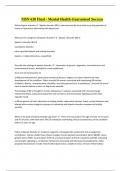MSN 620 Final - Mental Health Guaranteed Success
Define bipolar disorder ✔️Bipolar disorder (BD) is characterized by chronically occurring episodes of
mania or hypomania alternating with depression
What are the categories of bipolar disorder? ✔️bipolar I disorder (BD-I)
bipolar II disorder (BD-II)
cyclothymic disorder
other specified bipolar and related disorders
bipolar or related disorders, unspecified.
Describe the etiology of bipolar disorder. ✔️interaction of genetic, epigenetic, neurochemical, and
environmental factors. Heritability is well established.
short arm of chromosome 11
childhood maltreatment, particularly emotional abuse or neglect, has been linked to the later
development of the condition. Other stressful life events associated with developing BD include
childbirth, divorce, unemployment, disability, and early parental loss. In adulthood, "stressful life event"
came 6 months before a manic or depressive episode.
The etiology of BD is thought to involve imbalances in systems associated with monoaminergic
neurotransmitters, particularly dopamine and serotonin, and intracellular signaling systems that
regulate mood.
a diffuse pattern of brain alterations including smaller subcortical volumes, lower cortical thickness and
altered white matter integrity in groups of individuals with bipolar disorder compared to healthy
controls
When is the peak of bipolar disorder age wise? ✔️There are two peaks in the age of onset: 15-24 years
and 45-54 years, with more than 70% of individuals manifesting clinical characteristics of the condition
before 25 years of age.
Patho of bipolar disorder ✔️Evidence supports a strong genetic component and an epigenetic
contribution. Human studies have shown changes in brain-derived neurotrophic factor (BDNF), nerve
growth factor (NGF), neurotrophin-3 (NT-3), and neurotrophin-4 (NT-4) in patients with BD, indicating
neurotrophic signaling is a molecular mechanism associated with decreased neuroplasticity. Other
proposed mechanisms include mitochondrial dysfunction, oxidative stress, immune-inflammatory
, imbalance, and compromised hypothalamic-pituitary-adrenal axis. Additionally, neuroimaging studies
have shown "evidence of change in regional activity, functional connectivity, neuronal activity, and
bioenergetics associated with BD," and anatomic studies have revealed dendritic spine loss in the
dorsolateral prefrontal cortex in the post-mortem brain tissue of patients with BD.
What are some characteristics that can increase the likelihood of a bipolar rather than unipolar
diagnosis? ✔️Inquiry into past hypomanic or manic episodes is particularly important for patients with
early onset of their first depressive episode (ie, in patients younger than 25 years), a high number of
lifetime depressive episodes (5 or more episodes), and a family history of bipolar disorder. These
findings in the patient's history have been shown to increase the likelihood of a bipolar rather than a
unipolar diagnosis.
Other factors increasing the likelihood of a diagnostic change from MDD to BD include the presence of
psychosis, unresponsiveness to antidepressants, the induction of manic or hypomanic symptoms by
antidepressant drug treatment, and polymorbidity, defined as 3 or more comorbid conditions.
Describe the criteria to diagnose BD-I ✔️Criteria met for at least one manic episode, which might have
been preceded or followed by a hypomanic episode or major depressive episode (hypomanic or major
depressive episodes are not required for the diagnosis).
Describe the criteria to diagnose BD-II ✔️Criteria met for at least one current or past hypomanic
episode and a major depressive episode; no manic episodes.
Describe the criteria to diagnose cyclothymic disorder. ✔️Hypomanic symptoms that do not meet the
criteria for hypomanic episodes and depressive symptoms that do not meet the criteria for major
depressive episodes in numerousperiods (at least half the time) for at least 2 years (1 year in those aged
≤18 years); criteria for major depressive, manic, or hypomanic episodes have never been met.
Describe the criteria to diagnose specified bipolar and related disorders ✔️Bipolar-like phenomena that
do not meet the criteria for BD-I, BD-II, or cyclothymic disorder due to insufficient duration or severity,
ie, 1) short-duration hypomanic episodes and major depressive disorder, 2) hypomanic episodes with
insufficient symptoms and major depressive episode, 3) hypomanic episode without a prior major
depressive episode, and 4) short-duration cyclothymia.
Describe the criteria to diagnose unspecified bipolar and related disorders ✔️Characteristic symptoms
of bipolar and related disorders that cause clinically significant distress or impairment in social,




